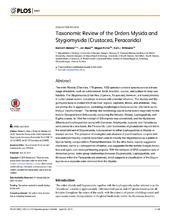| dc.description.abstract | The order Mysida (2 families, 178 genera, 1132 species) contains species across a broad range of habitats, such as subterranean, fresh, brackish, coastal, and surface to deep-sea habitats. The Stygiomysida (2 families, 2 genera, 16 species), however, are found primarily in subterranean waters, but always in waters with a marine influence. The Mysida and Stygiomysida body is divided into three main regions: cephalon, thorax, and abdomen. They are shrimp-like in appearance, containing morphological features earlier referred to as defining a "caridoid facies". The shrimp-like morphology was to some extent diagnostic for the historic Decapod taxon Schizopoda, containing the Nebalia, Mysida, Lophogastrida, and Euphausiacea. In 1904 the concept of Schizopoda was abandoned, and the Mysidacea (Mysida and Lophogastrida) along with Cumacea, Amphipoda, Isopoda, and Tanaidacea were placed in a new taxon, the Peracarida. Later discoveries of groundwater mysids led to the establishment of Stygiomysida, but placement to either Lophogastrida or Mysida remained unclear. The presence of oostegites and absence of podobranchiae, coupled with non-statocyst bearing uropods have been used to classify the Stygiomysida as a primitive Mysida family, comparable to Petalophthalmidae. On the other hand, equally suggestive characters, but for a Lophogastrida affiliation, was suggested for the archaic foregut characters and again, non-statocyst bearing uropods. With the inclusion of DNA sequence data of ribosomal genes, sister group relationships between Stygiomysida, Lophogastrida, and Mictacea within the Peracarida are observed, which supports a classification of the Stygiomysida as a separate order removed from the Mysida. | en_US |

